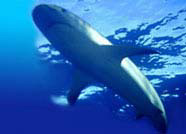


Shark Repellents

 |
 |
 |
|||
| Home | Evolution
| Classification
| Glossary | Biology
| Behavior | Shark
Repellent | Shark
Conservation | Do's &
Don'ts | Did You Know?
Shark Repellents |
 |
||||
|
 With
the number of increasing attacks seen in Shark prone areas, Scientists
are now searching for a way to keep sharks away from the swimmers and
divers. Some answers have been found and some yet to be discovered. A
truly effective shark-repellent is found in harmless-looking flounder
called "Moses Sole" which secrets a milky substance on its predator.
This substance temporarily paralyzes or "freezes" the predator
and give the fish a chance to escape. Scientists are still looking for
a way to extract this substance from "Moses Sole" and use it
against sharks. With
the number of increasing attacks seen in Shark prone areas, Scientists
are now searching for a way to keep sharks away from the swimmers and
divers. Some answers have been found and some yet to be discovered. A
truly effective shark-repellent is found in harmless-looking flounder
called "Moses Sole" which secrets a milky substance on its predator.
This substance temporarily paralyzes or "freezes" the predator
and give the fish a chance to escape. Scientists are still looking for
a way to extract this substance from "Moses Sole" and use it
against sharks.Apart from that, there have been researches and scientists who are working with semiochemicals (Repellent Semiochemicals). Repellant semiochemicals are typically pheromones or allomones. Pheromones can be used to communicate to pests that the host is too crowded and thus unsuitable for colonizing. Allomones acting as non-host volatiles can also signal that the prospective host is incompatible. For example, hardwood tree volatiles can be used to protect valued coniferous trees from attack by conifer seeking pests. The new repellent, from a New Jersey company called Shark Defense, was based on chemicals found in dead sharks. In searching for something that would send sharks packing, chemical engineer Eric Stroud focused on naturally occurring signaling chemicals. Researchers say they have developed a shark repellent that uses apparently natural chemical signals to shift the animals from hunting mode to flight mode. If it proves to be effective and environmentally safe to use, it could soon become standard-issue for everyone who comes into contact with the marine predators-from surfers to commercial fishers. These molecules include the pheromones that animals use to communicate. Moths, for example, release pheromones to announce mating season. Starting from the observation that sharks dislike dead sharks, Stroud apparently worked through a process of elimination to come up with "complex water-soluble molecules" which don't seem toxic to sharks or other fish. The repellent has yet to square off against the white shark, which causes 87 percent of human attacks on the Pacific coast of North America. To date, six different species have been effectively repelled by the mixture, which was dropped from a boat into a chum-filled sea of feeding sharks. "They stop feeding, go into alarm mode, and they rapidly leave," Stroud explained. "Once they detect this, we suspect by olfactory senses, there's definitely a behavioral change, and they either go deep or leave the area. The repellent even seems to work on sharks that are feeding. It also works during the state of "tonic immobility." When a shark is held upside down, you can perform surgery without anesthetic. The new repellent causes immobile sharks to wake up and fly right away! Apart from above efforts, there have been researches on "Electrical repellent" of sharks. This kind of repellent was designed for commercial Scuba Divers, because recreational Scuba Divers want to "see" sharks rather than to repel them! The concept was later modified for use by commercial, surface-supply divers, who obtain their air from the surface via an airline. The Shark POD Diver Unit consisted of three components linked by cables. The main body of the Diver Unit, housing a small rechargeable 12 V battery pack and one stainless steel electrode, was strapped to the dive cylinder. The foot electrode was attached to one of the diver's fins. The activating switch, which also housed the low battery warning light, was brought over the shoulder to make it easily accessible. Separated by at least 1.5m, the two electrodes created an electrical field around the diver, which was designed to repel sharks approaching from any direction. This field appeared to affect the shark's sensory and neuromuscular systems and discouraged the shark from remaining in the immediate vicinity. The Shark POD proved effective in scientifically controlled field tests, repelling sharks that came "too close for comfort" (i.e. 1m from the Shark POD). Most of these tests were conducted on white sharks Carcharodon carcharias on South Africa's southwest coastline, which is internationally renowned as the best region in which to encounter this species. Tests against the other two species of dangerous sharks which divers are likely to encounter in nearshore waters, namely the tiger Galeocerdo cuvieri and the bull (Zambezi) shark Carcharhinus leucas, were limited but with good results. The effectiveness of the device varied according to species, and some harmless sharks, such as the nurse shark Ginglymostoma cirratum, showed little reaction to the electrical field. The Shark POD Diver Unit was designed to be activated immediately on entering the water and switched off again only when leaving the water. The device was not intended to be switched on and off during a dive as a startle device - it functioned by keeping sharks at bay. When used correctly, the electrical field was not strong enough to cause undue discomfort to humans. It could save diver from cruising sharks but same in case of aggressively hunting shark, is difficult. Glossary
|
|
|||||||
| Sitemap | Reach To Us | Jimtrade - Business Directory of India | ||||||||